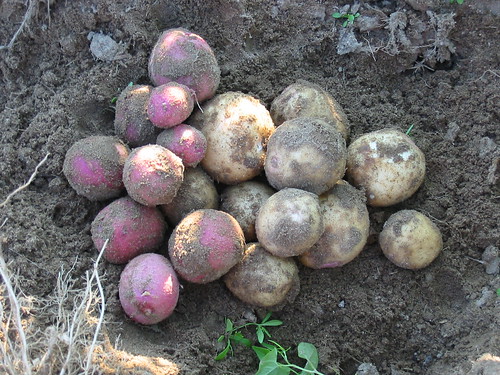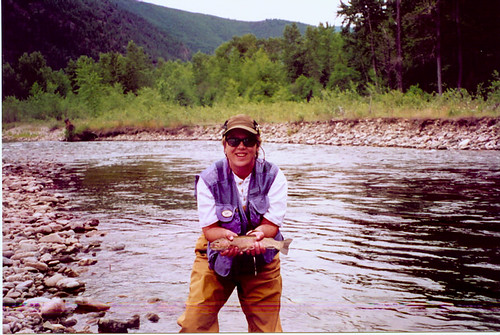Shiawassee River [July 31 2005]
We finished off our weekend with a quick evening fish on a nearby warmwater river. We have developed this habit over the past few summers. The Shiawassee is close to home, easy to wade and fish, and has an abundant population of smallmouth bass. It's a quick drive to get on the water and I can feed my spey casting habit, so it's a nice relaxing way to end an evening or a weekend. Recently though, we've only fished the Shiawassee 3 times in 2 months.
Tonight, the water level was waaaay above average - still high from recent thunderstorms. Wading was still pretty easy, but the fish were not present in their usual, predictable locations. I swung white and yellow streamers on a sink tip and found only 2 interested fish in 3+ hours of fishing. They were both smallish 10-11" pictures of health. Both came from the edge of a swift seam at the bottom of a deep slot. I thought I'd find them by casting into slower pools and swinging the fly out into the main current tonight, but instead found them in the quicker water. B tried her old smallmouth standby, a tan and white beadhead woolly bugger and had no luck. She switched to other streamers - conehead leeches, muddlers, etc. and still nothing. She ended her evening by stripping a Gartside Gurgler, a recent discovery and favorite, but it sparked no fish interest. It almost never happens, but B finished the night with a 'skunk.'
Stats
Ratio of actual to expected fish catch: 1:6
Wildlife sightings: 1 very crabby great blue heron, 1 very friendly dog, 1 carp, lots of cedar waxwings
Did I get to use a spey rod?: Yeeeaah, baby.
Probability of B getting skunked while I catch 2 fish: 1%
Suburban Stream [July 30 2005]
Evening Browns and Cedar Waxwings
B and I visited a relatively suburban stream on the west side of the state last night for an evening fishing outing. We should've tried to hook up with Speytrout, but I guess we weren't planning far enough ahead. This trout stream is small (normal flow for this time of year is about 130 ft3/min); the best upper stretches are a series of well-shaded riffles and pools that run over a bottom of gravel, rubble and sand through privately owned, fairly dense lowland hardwoods.
We arrived at the river at about 7:00 PM and found a single angler packing up his rod and leaving. This is a rather popular stretch to fish and we felt lucky to be the only anglers present. We didn't assume it would remain that way, but we never ran into any other fishermen during the evening. We quickly rigged up our 5-weights, hiked down to the water, waded in and began fishing downstream; B hiked down the bank a ways and waded below me, out of sight.
I didn't really have a strong feeling about an appropriate fly to begin with. For lack of a good idea, I tied on a light-colored terrestrial/hopper imitation, though I didn't have any confidence in this choice. In fact, I felt no confidence or inspiration at all about how to approach the water before me. I thought this was sort of strange; I'd fished this water enough times. "Hmmm....oh well, just start casting and go from there," I told myself.
There were a few risers here and there - seemingly smaller fish. And I couldn't really tell what they were rising to. I casted to a few and provoked no interest in my big fly, so I switched to a small, light colored Wulff pattern. I had noticed a small variety of flying insects - a few light caddis, even a couple of whiteflies. Whiteflies already? There was no single insect that seemed to predominate, so I was left to continue my unfocused, unconfident approach. I quickened my pace through a short, featureless stretch toward a particularly fishy area, but I saw no rises or a change in insect activity as I approached it. I casted through seemingly likely seams and holding areas here, but ended up wading right through it without turning a fish.
It was now dusk-ish and I came to a shallow, riffly bend. I figured I'd find B fishing below, through a long, straight series of riffles and exposed stones and stumps. I also noticed a good omen at this bend - about a half-dozen cedar waxwings (Bombycilla cedrorum) furiously flycatching back and forth, and up and down the river. They were flying low to the water, so I suspected I might be stumbling into a section of hatching insects, rather than waiting for a fall of insects high above the water. Maybe they were eating the gatrillion mosquitoes that were buzzing around. I'd be OK with that too. I didn't notice any big change in surface bug action, though there were still a few surface disturbances. I switched flies to a soft-hackle hare's ear. Maybe I could find fish feeding just below the water surface. Perhaps the fish were feeding on something small, like BWOs, and I couldn't see them. I saw B way downstream and hollered to her. She'd not had a lot of luck with her ant pattern, but had stimulated a few short strikes.
I began swinging and lifting my wet fly and after only a few swings, I hooked a reasonable fish and lost it after only a few seconds. OK, this is an improvement. A few more downstream paces and swings and I hooked and lost another little one after a brief tussle. Two tugs and the sudden transformation in my confidence was so remarkable that I took notice. Isn't it amazing that I could go from an entirely aimless, unsure, stab-in-the-dark guessing game to a just-keep-doing-what-you're-doing-and-it'll-work feeling in a few minutes? Now I knew what I was doing when a few minutes prior, I didn't have a clue. I think I spend a lot of time in this state of Vaguely Clueless while fishing. Maybe we all do. I don't know.
A canoe passed by with 2 dads on the paddles and 3 little girls stowed between them. They were apparently having a deep discussion during their paddle. I overheard an inquisitive young voice ask "Dad, are there people in Japan?" And B reported later that a little blondie asked "Dad, what is that lady eating?" after they passed her while she was blowing on her fly to dry it off. I caught a couple of little 7-inch confidence boosters before B and I turned around headed back upstream. I switched to a brown, Wulff-ish isonychia pattern. We fished upstream a ways, which was not easy for either of us. We've both become downstreamers - apparently more comfortable with swings and active presentations than with dead-drifts. We casted dries to a few risers and got a few more splashy short strikes. Short strikes were developing into a theme for the evening too. I caught a nice 9" brown that had been rising regularly to something but required several casts to take my fly.
It was now 9:30-10:00, the sun was well down and we figured we should be wading an impediment-free, roomy backcast, likely big-fish stretch when darkness settled in. We hiked up to a typically high-yielding log jam and waded back in. B fished below me and we both were secretly hoping for a small hatch of just a few straggling Hex (Hexagenia limbata mayfly) to turn on some big brown trout. I think we saw 2 Hex on the evening - not quite a 'hatch.' We both switched to big flies - B tied on a black Gartside Gurgler, and I chose a large Muddler Minnow. I had only one strike on my Muddler, (not counting a muddler-eating tree branch over my head) but it was a nice one. I landed a feisty, slim, colorful, 13" brown. We ended our evening in heart-pounding fashion. B had been working a particularly active area above a logjam against the bank. She caught a couple browns and a rainbow, and several more fish had smashed her Gurgler without being hooked. One fish, that seemed especially large, hit it 3 times on a single retrieve. She finally hooked him a bit later; he was a biggie. I happened to have my headlight on and aimed downstream, and I saw the splash as he jumped. He was big. We never got a clear view of the entire fish, he threw the hook after a violent, 10-second fight. I would guess that he was probably in the 16-20" range. It was about 11:30 and we decided to end the night on that fish. B's heart was still pounding on the walk back to the car.
Stats
Main features: short strikes, milieu of bugs, psychological and cardiac exercise
Angling satisfaction (on a scale of 1 to 10): 9
Wildlife sightings: belted kingfisher, great blue heron, cedar waxwings, baby canoers
Equipment review: bright, 3-bulb, cap-mounted headlight from Gates' AuSable was a very good purchase; the Gartside Gurgler is a great, underappreciated pattern
Did I get to use a spey rod? No
Enjoyment grade for the day: A
Long time no post....
 Sorry for the blog neglect. It's been a busy week - weeding, sample collection, root separation and washing, and getting two field experiments ready for a field day today. This afternoon, I'll be busy with farm tours, plot-side presentations, and a barbecue dinner followed by more wagon tours until dusk. The weather's perfect for it - 80o and sunny. It'll all be over tonight.
Sorry for the blog neglect. It's been a busy week - weeding, sample collection, root separation and washing, and getting two field experiments ready for a field day today. This afternoon, I'll be busy with farm tours, plot-side presentations, and a barbecue dinner followed by more wagon tours until dusk. The weather's perfect for it - 80o and sunny. It'll all be over tonight.
 My sister from Chicago visits this weekend with her 2 little ones. We'll get to introduce Patrick to our new dog, Dylan. I know they'll get along famously. Patrick has missed having a dog in the house since his beagle, Idie, passed away a couple of years ago. I'm looking forward to hanging with them and to a little outdoor recreation instead of outdoor toil....though my vegetable garden needs a lot of work too.
My sister from Chicago visits this weekend with her 2 little ones. We'll get to introduce Patrick to our new dog, Dylan. I know they'll get along famously. Patrick has missed having a dog in the house since his beagle, Idie, passed away a couple of years ago. I'm looking forward to hanging with them and to a little outdoor recreation instead of outdoor toil....though my vegetable garden needs a lot of work too.
Tangled Bank #33 is available
evolgen is hosting the current installment of The Tangled Bank. TB#33 is all neatly organized and available for perusal. RPM at evolgen has done a brilliant job organizing all the submissions by research or commentary category. Essays include subjects from the physical sciences, biological sciences, medicine, and other scientific fields.
I'm honored to be occupying the 'Agricultural and Plant Biology' category together with Nuthatch with posts about the poetry of leaves (very cool) and 'new' potatoes.
Thanks RPM!
Hairy Popper and the Chamber of Sunfish
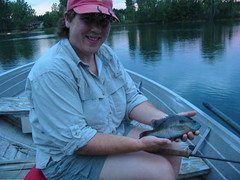 We headed to Clare county on Saturday to visit B's parents, take our new puppydog swimming and fish a small gravel-pit lake that is owned entirely by her family. Dylan enjoys the water quite a bit, but is still reluctant to wade deep enough to warrant paddling - even for a magic tennis ball. This is a lake that has spoiled us for warmwater fishing - it receives only a low to moderate fishing pressure and most fish are caught and released. It has some very nice pike and crappie, but we mainly target the larger-than-typical largemouth bass and bluegills. The big bluegills are a lot of fun on a flyrod. Because of their wide flat body and their tendency to turn sideways and run in big arcs when they're hooked, they are tough little fish to land.
We headed to Clare county on Saturday to visit B's parents, take our new puppydog swimming and fish a small gravel-pit lake that is owned entirely by her family. Dylan enjoys the water quite a bit, but is still reluctant to wade deep enough to warrant paddling - even for a magic tennis ball. This is a lake that has spoiled us for warmwater fishing - it receives only a low to moderate fishing pressure and most fish are caught and released. It has some very nice pike and crappie, but we mainly target the larger-than-typical largemouth bass and bluegills. The big bluegills are a lot of fun on a flyrod. Because of their wide flat body and their tendency to turn sideways and run in big arcs when they're hooked, they are tough little fish to land. 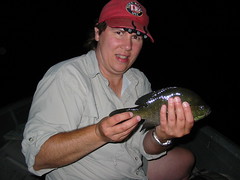 Last year we had a phenomenal day of bluegill fishing here. I can't even guess how many we caught. That day, the largest was 11", the smallest was 9" and all the rest were in between.
Last year we had a phenomenal day of bluegill fishing here. I can't even guess how many we caught. That day, the largest was 11", the smallest was 9" and all the rest were in between.
We didn't have quite that level of super hot fishing on Saturday, but we're not complaining. We started fishing at about 5PM and fished until about 10:30 with a short respite for dinner. A light rain fell the whole time but was never enough to drive us inside. I used my 9' 6wt Lamiglas 'stick' and B chose her big 9'6" 7 wt Scott to enable chucking big flies. I tied on a black Gartside Gurgler and had immediate success finding bass up against the cattails bordering the lake. Earlier this summer, B had been noticing that, due to the hot weather and warm water, both the bass and bluegills were mostly found in the deeper areas of this lake. 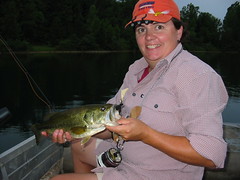 I was surprised to find bass up in the shallows now. B was using a deer hair popper and enjoyed some interest early on, but declining action later, so she switched to the Gurgler too. Because of the way our row boat tended to drift, B ended up casting out into deeper water for most of the evening and I targeted the shallow water near the bank. B caught only big bluegills out in the deep and I caught big bass in shallow with maybe only one or two bluegills.
I was surprised to find bass up in the shallows now. B was using a deer hair popper and enjoyed some interest early on, but declining action later, so she switched to the Gurgler too. Because of the way our row boat tended to drift, B ended up casting out into deeper water for most of the evening and I targeted the shallow water near the bank. B caught only big bluegills out in the deep and I caught big bass in shallow with maybe only one or two bluegills.
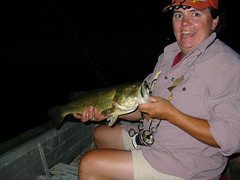 The bluegills that B caught were really nice - colorful and healthy and ranged from 9" to 11" again. The littler ones were too small to hook on the large Gurgler fly, though a few tried. I caught bass ranging from probably 11" to 17". The big one showed evidence of a rough life - he had a very raggedy dorsal fin and tail. We measured and photographed a few of the biggest fish. There's another bluegill picture in my Flickr photostream. I have to say, these fish were a fun challenge even on stiff 6- and 7-weight rods. The bass doubled my rod right over heading for the safety of the bottom and the big bluegills put a serious bend in B's 7-weight.
The bluegills that B caught were really nice - colorful and healthy and ranged from 9" to 11" again. The littler ones were too small to hook on the large Gurgler fly, though a few tried. I caught bass ranging from probably 11" to 17". The big one showed evidence of a rough life - he had a very raggedy dorsal fin and tail. We measured and photographed a few of the biggest fish. There's another bluegill picture in my Flickr photostream. I have to say, these fish were a fun challenge even on stiff 6- and 7-weight rods. The bass doubled my rod right over heading for the safety of the bottom and the big bluegills put a serious bend in B's 7-weight.
Stats
Doggy swimming teacher grade: C-
Angling satisfaction (on a scale of 1 to 10): 10
Review of Repel lemon eucalyptus mosquito repellent: Thumbs up
Did I get to use a spey rod? Negative
Enjoyment grade for the day: A. Big fish, family & a tired soggy dog
First attempt at digiscoping
 I tried digiscoping today for the first time. I saw Mike's first attempt and figured I should give it a try. I'm not a good photographer, but I've got a lower-end spotting scope (Wind River 15-45X) and camera (Canon A40) so what the heck... Here's a picture of a pair of super exotic house sparrows using the nest box at the corner of my garden, with our 'mullein forest' (Verbascum thapsus L.) as the background.
I tried digiscoping today for the first time. I saw Mike's first attempt and figured I should give it a try. I'm not a good photographer, but I've got a lower-end spotting scope (Wind River 15-45X) and camera (Canon A40) so what the heck... Here's a picture of a pair of super exotic house sparrows using the nest box at the corner of my garden, with our 'mullein forest' (Verbascum thapsus L.) as the background.
Well, I have to say that my initial results were mixed. I figured out how to get rid of the vignetting fairly quickly by zooming my camera to 3X. But I'm manually holding my camera at the scope eyepiece so any jiggling of the camera, scope or tripod results in a fuzzy picture. Plus, it takes a few seconds to get the proper camera-scope alignment, so unless the subject is fairly sedate, it might fly off before I can capture it. I can easily see the advantages of a fixed camera-scope adapter.
This technique is definitely worth pursuing a bit since I may be able to get a photo of an otherwise out-of-reach subject once in awhile. As long as it's not in a hurry. Thanks for the suggestion Mike!
Science can be tasty!
I've been enjoying new potatoes from my garden for the past 2 or 3 weeks. I have a suspicion there are those among us who may miss this wonderful summertime pleasure. For others, new potatoes are one of those aspects of summer that, though universally considered to be wonderful and special, often go without formal acknowledgement. So, let's fix that shall we?
Have you got a row of Irish potatoes (Solanum tuberosum) in the garden? There is no need to be patient and wait for fall to enjoy them. New potatoes are those harvested early, before the plants and tubers are fully mature. These beauties are harvested much earlier than traditional, fully developed fall-harvested tubers. They may be dug anytime from flowering through mid- to late-tuber development long before the vines begin to senesce and die. Eventually, as the plants mature and senesce, the tubers below ground mature physiologically and can't really be considered 'new' or 'early' anymore. Some folks also call new potatoes by other names - "creamers" or "steamers" for example. Back east we referred to them as "salt potatoes" for the way they were typically cooked by boiling in saturated salt water. New potatoes are often red varieties such as Red Pontiac or Red Norland. These varieties tend to grow and mature earlier than some other varieties, so they're chosen to speed the process of harvesting new potatoes. Round white varieties and newer, yellow-fleshed varieties like Yukon Gold are also popular for new potatoes. I've been harvesting Red Pontiacs and Yukon Golds from my garden this summer.
Though, many of the supermarket displays will try to convince you otherwise, small size is not an identifying feature of a new potato. Perhaps this year-round practice of offering impostor 'baby' potatoes has led to the diminished reputation of new potatoes somewhat. Grocery store potato bins will sometimes be labelled "baby reds" or "new potatoes" implying youthful features, when in fact they are not immature new potatoes at all. They are just small B-size (1-1/2 to 2-1/4" diameter) mature tubers harvested in the fall and stored until they're marketed just like any other bag of spuds. New potatoes tend to be small, but they don't have to be. 'New' in this context refers to a growth stage or physiological maturity, not a size. The main features of new potatoes are their very thin skin and creamy, tender texture. Additionally, if new potatoes have been stored or otherwise delayed in reaching your kitchen, their 'new' features will have been degraded substantially. Potato tubers are living plant tissue and continue to mature and develop characteristics of normal, fully-mature, fall-harvested tubers even after they are separated from the mother plant.
The most notable difference between a new potato and its mature sibling is the periderm. Potato periderm conains a secondary growth tissue or meristem called phellogen. The phellogen produces tough, protective cells toward the outer side of the plant tissue called phellem. Phellem cells form layers on the outside of the tuber. We potato consumers refer to the phellem as the potato's 'skin'. Phellem cells are small and dense and as they develop they 'suberize' and die, forming a protective layer around the tuber. These cells contain suberin, a waxy substance, which serves to protect inner tissues from dessication, pathogens and mechanical damage. Immature periderm has an outer phellem which not fully developed and is thin and delicate and is easily abraded or broken during handling, exposing the active phellogen layer underneath. Because immature, new potatoes have a delicate phellem or skin, they are not well suited to mechanical harvest, handling or storage. These features are also responsible for their elevated status as a summertime delicacy. For these physiological reasons, you're more likely to find better quality new potatoes from local farms and gardens than in supermarkets and chain stores where produce comes from the south or the west coast and travels thousands of miles for days in semi-trucks. By the time these spuds reach your kitchen they won't be 'new' any longer. The best way to acquire some of these beauties for your dinner table is to grow them yourself or to befriend your gardening neighbor. Dig them carefully just before dinner, clean them off and steam them with a little fresh-clipped rosemary and thyme to season them.
I can provide no good recommendations for storing these little gems as that is completely counter-intuitive...
I and the Bird #2 is up

Charlie's Bird Blog is the host of the second chapter of the I and the Bird carnival of birding stories. Today's installment includes my American Redstart post in addition to a lot of other great birding stories.
Look over there! It's Edith Clement!
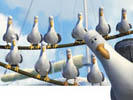
Jeez o' pete. Our MSM is so disappointing. Have you seen Finding Nemo? I'm thinking the gulls are a good approximation of their behavior.
I'm particularly disgusted with this weeks Supreme Court nominee bait-and-switch. Edith Clement was the bait; John Roberts was the switch. These reporter folks have GOT to stop using leaks as actual information. They need to realize that leaks = lies and avoid taking the hook. They have got to learn to detect these ridiculous deceptive tactics by the Bushies. Jeez, today, they're looking like a puppy dog unaware that the tennis ball never left master's hand.
Even a dog catches on eventually...
ADDENDUM: A similar sentiment on the AlterNet blog.
Paper to dispute Ivory-billed woodpecker sightings
Nuthatch at Bootstrap Analysis has an analytical preview of a soon-to-be-published paper by a Yale ornithologist disputing the recent Science paper describing the sightings. A good read...
ADDENDUM:
Tony G at MilkRiverBlog has more commentary on this upcoming publication...
ADDENDUM ADDENDUM:
Nuthatch has more.
Flip Flop...
Atrios has a side-by-side comparison of Shrub's statements regarding the possibility of someone on his staff having dirty hands in this Iraq-Niger-WMD/Plame/Rove/Cooper-Novak-Miller matter.
Additionally, ABC has a poll out today showing that an overwhelming majority of Americans believe that the Bush Whitehouse is slimy on this issue.
Also, some of the guilty ones are beginning to float the unlikely notion that Powell is the person responsible for leaking Plame's name to the media.
ADDENDUM:
Milkriverblog links to a related, and uplifting, story in the DailyKOS diaries...
It's too hot and humid to go fishing...
We've been so atypically hot and humid here it's getting ridiculous. How weather is bearable if the humidity isn't too bad, but this week we've had oppressive humidity in combination with 85+ degrees. It's even too uncomfortable this weekend to go fishing. That's bad...
In the meantime, Lené at Leaning Birch posted a nice little collection of excerpts from some fishing-oriented essays. Check them out.
Michigan's Kirtland's Warbler population at a record high
 A July 11 MIDNR press release indicates that Michigan's Kirtland's Warbler (Dendroica kirtlandii) population is growing and numbered over 1400 singing males during the 2005 census carried out by the MI DNR, the US Fish and Wildlife Service, the US Forest Service, MI Department of Military Affairs and lay volunteers. This is the largest number counted since the survey began in 1951. The population reached a low point in the 70's and 80's when minimum counts of 167 males were observed. The 2004 census counted 1348 singing males.
A July 11 MIDNR press release indicates that Michigan's Kirtland's Warbler (Dendroica kirtlandii) population is growing and numbered over 1400 singing males during the 2005 census carried out by the MI DNR, the US Fish and Wildlife Service, the US Forest Service, MI Department of Military Affairs and lay volunteers. This is the largest number counted since the survey began in 1951. The population reached a low point in the 70's and 80's when minimum counts of 167 males were observed. The 2004 census counted 1348 singing males.
Singing male warblers were observed in 11 lower penninsula counties and a few were observed with females in 5 upper penninsula counties.
The Kirtland's warbler depends on young jack pine stands from 4 to 20 years old for nesting. With fewer natural forest fires today, young jack pine forests must be created with managed burning, clearcutting, reseeding and replanting. The organizations involved replant and reseed over 3000 acres in Michigan each year to provide a continuous habitat resource for this population. Additionally, special programs such as cow bird trapping and removal helps to keep warbler populations growing by reducing nest parasitism pressures.
Other good news from MI DNR - Michigan's Gray Wolf (Canis lupus) population continues to increase:
Department of Natural Resources officials today announced results of the most recent wolf survey, which indicates at least 405 wolves are now roaming Michigan's Upper Peninsula, a 13 percent increase from the 360 animals counted in 2004. The survey was conducted during the winter months when wolf numbers are at their lowest.
Tangled Bank #32 is up
TechnoGypsy is hosting the current installment of The Tangled Bank. TB#32 is all assembled and available for perusal. I'm pretty impressed that the TechnoGypsy managed this accomplishment even though he's on the road, at a conference, with a dead laptop.
I'm happy that my recent post entitled Anything of value must be 'engineered' is included.
Should Rove be fired?
Right now, 48,000+ have voted and the results are:
88% - Yes
10% - No
2% - Don't know
Here's the best quote I've seen on the subject of the Rove/Plame leak so far this morning:
If a Mob Boss Says to a Hit Man, "Kill Jim Smith's Wife," Can He Claim He Didn't Order the Murder Because He Didn't Mention Her Name? Apparently, That's Karl Rove's Thinking.
Muskegon River [July 9 2005]
I spent the day trout fishing on the Muskegon River between Croton and Newaygo on Saturday. I had a chance exercise my spey rod and to hang out and fish with some of my favorite fishing pals. The Flygirls were getting together in Newaygo for an all-day outing and I met up with my friend Speytrout too.
The flow rate for this river section is currently well below average resulting in low, warm, clear conditions. On top of that, the day was hot, clear and sunny creating conditions that disappoint most trout anglers but that please the zillions of tubers and paddlers out for a weekend float.
I left home rather late and so did not meet up with the Flygirls contingent at 7:00 AM, but instead headed directly to the river to meet Speytrout at 10:00. I had been looking forward to fishing the Mo so that I'd have a chance to use my 7 weight spey rod again. I don't practice or enjoy my spey rod as often as I'd like because I end up fishing smaller streams most of the time. I need to include bigger rivers in the rotation more frequently. I parked the car next to Speytrout's, rigged up my rod and waded well upstream to a favorite stretch. I found it unoccupied and also free of paddlers and tubers at this hour. Speytrout was nowhere in sight.
I tied on a sinktip and a small white marabou streamer and began fishing down this long stretch of somewhat shallow water (2-4 feet deep) with ocassional deeper pockets and holes. I hadn't gotten very far when 2 Flygirls, Jen and Mandy, floated through in their canoe. We chatted for awhile. They had put in at the dam and planned to paddle and fish down to the city park by early afternoon. After they continued on their way, I hooked and landed a few smallish rainbows, about 11-12" . I got 5 in total, all the same size with wide, bright pink sides from their cheeks to their tails. They must be stocked fish to all be so uniform in size and appearance. If you're going to catch little trout on a 7 weight spey rod though, I recommend these. One advantage about my oversized setup was the quick fish landing process - all fish released quickly even in the warmish 70 oF water. Just as I reached the spot on the bank where I entered the river, I noticed Speytrout wading up in my direction. We chatted, swapped rods for a while and he helped my tune up my speycasting a bit. Speytrout is almost wholly committed to speycasting now - having dispensed with most of his single-handed rods. I always manage to learn some good stuff when I fish with him.
We headed back to the cars and went into town for some lunch with the Flygirls. Speytrout took off after lunch, but not before bestowing a couple of his new foam-bodied wakers and a couple of good-looking tube flies. He also sold me a hand-me-down 5 weight that I've been coveting. At the park, I ran into the Flygirl group - Dorothy, Kris, Tina, Becky, Ann, and Mandy and Jen again. It was early afternoon and the tube and paddler traffic had steadily increased to a continuous stream. It's a great river for this kind of recreation. Fishing success was unlikely, but Dorothy and I fished a short stretch to fill the time before dinner. Neither of us caught anything.
We met up with a few more Flygirls for dinner at the Red Anchor Inn in Croton. Dinner was quite good and I met a few more Flygirls - Judy, Fran and Colleen. Dinner conversation was lively and seriously entertaining. Flygirls has some comedians among its ranks. After dinner, several of us planned to meet on the river for the evening hatches. I arrived first and rigged up the new 9'9" 5wt I relieved Speytrout of earlier in the day. Beautiful rod. In a few minutes Becky joined me and we hiked down to the river for an hour of waiting and watching but no rising fish. I benefited from the chance to practice casting a single-handed rod for awhile. I was having trouble summoning the coordination necessary after becoming accustomed to the two-hander earlier. After a long while of no fish action, I decided to wade upstream to see if I could find the rest of the group. I found them around the first bend, spaced well apart and casting to rising fish. I jumped in downstream of everyone and attempted to identify the bug action. I saw no obvious bugs (I often don't) and the rising fish did not necessarily appear to be large. I figured I'd tie on something to imitate an isonychia in case that's what was causing the action. I chose a Wulff-ish tan/brown dun pattern in size 12 or so. I'm not sure if this was the best choice, but the fish I'd been watching seemed to think it was close enough. Without wading very far, I caught 4 or 5 more rainbows fitting the same description as those I'd hooked in the morning and a little steelhead smolt that had me convinced he was a larger trout for a few seconds. He dove into some grass and I couldn't budge him. Eventually he came up and I was surprised to see that he was only 8 or 9" in length. I'm not sure how everyone else did as we were spaced out far enough to discourage a lot of chatter. I did hear someone exclaim about landing a 16" fish - Tina I think. The feeding activity slowed down to a trickle at about 10:00 and we all decided to quit for the night. Some of the women were staying in the area overnight and others of us were hoping for a deer-free drive home.
All in all, it was a great day. I got to hang with some great people, make myself sore from speycasting, and I didn't get skunked.
Stats
Social satisfaction (on a scale of 1 to 10): 10+
Angling satisfaction (on a scale of 1 to 10): 10
Wildlife sightings: great blue herons, belted kingfishers, swallows, about 900 tubers, 1 bald eagle
Did I get to use a spey rod? Yesssssss!
Enjoyment grade for the day: A. I've been telling stories since I got home.
U.S. Leadership in Science and Engineering Threatened
A study published by the National Bureau of Economic Research finds that the US is losing its dominance in science and engineering fields as other nations are producing more graduates and offer more employment opportunities.
A Reuters news article summarizes the research article:
[...]
In 2000, the paper said, 17 percent of university bachelor degrees in the U.S. were in science and engineering compared with a world average of 27 percent and 52 percent in China.
The picture among doctorates -- key to advanced scientific research -- was more striking. In 2001, universities in the European Union granted 40 percent more science and engineering doctorates than the United States, with that figure expected to reach nearly 100 percent by about 2010, the study showed.
The study said deteriorating opportunities and comparative wages for young science and engineering graduates has discouraged U.S. students from entering these fields, but not those born in other countries.
[...]
The researchers propose that:
[...]
Diminished comparative advantage in high-tech will create a long period of adjustment for US workers, of which the off-shoring of IT jobs to India, growth of high-tech production in China, and multinational R&D facilities in developing countries, are harbingers. To ease the adjustment to a less dominant position in science and engineering, the US will have to develop new labor market and R&D policies that build on existing strengths and develop new ways of benefitting from scientific and technological advances in other countries.
I think the pro-factual, pro-scientific climate created by the Bushies oughtta be just the ticket!
Wow. A first-hand description of aTube bombing in London yesterday
Justin at 'Pfff' was on the Tube train that was destroyed by a bomb yesterday.
He describes his experience on the train yesterday, and the events of today, the day after.
Wanna see some animal pictures?
The Modulator has its regular 'Friday Ark' post linking to animal pictures posted on blogs all over the internet...
And here's a collection of recent birding stories and pictures at the first installment of the "I and the Bird" carnival conceived by, and hosted by, 10,000 Birds
Potato porn
Tonight's dinner will be the second already this week that we've had fresh new potatoes from the garden. These are early varieties, Yukon Golds and Red Pontiacs. Oh sure, they're small - only 1/2 to 2". But I can make a really strong argument that this is when they're best...
Pine River, part 2 [June 23 2005]
I've already written a bit about our fun experiences on day 4 of our OCFF vacation, but there's a little more to fill you in on...
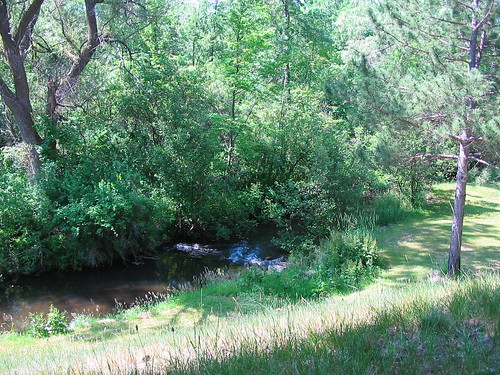 Drug dealers need their rest, so we slept in late again and enjoyed coffee and breakfast outside on the bank overlooking the little stream. B watched the resident snapper amble upstream again, chasing nice brown trout out of his path. He emerged onto the bank and headed up the bank a bit to a nice, sunny resting spot. She called me outside to take a look - he had a big, black, engorged leech stuck to the back of his neck, between his head and shell. Probably a pretty hard place to properly maintain if you're a turtle. I would have loved to help him remove it, but not at the risk of losing my digits. Given where they spend most of their time, I suppose these big, mature snappers have dealt with their share of leeches. He hunkered down on the grassy bank in the warm sunshine. Maybe he was going to drive the leech off by threat of dessication.
Drug dealers need their rest, so we slept in late again and enjoyed coffee and breakfast outside on the bank overlooking the little stream. B watched the resident snapper amble upstream again, chasing nice brown trout out of his path. He emerged onto the bank and headed up the bank a bit to a nice, sunny resting spot. She called me outside to take a look - he had a big, black, engorged leech stuck to the back of his neck, between his head and shell. Probably a pretty hard place to properly maintain if you're a turtle. I would have loved to help him remove it, but not at the risk of losing my digits. Given where they spend most of their time, I suppose these big, mature snappers have dealt with their share of leeches. He hunkered down on the grassy bank in the warm sunshine. Maybe he was going to drive the leech off by threat of dessication.
We again packed a bountiful lunch and dinner of PB&Js and other tasty sundries in the cooler and headed off for a full day of fishing. We chose to fish the Pine River along the Silver Creek pathway. We'd never fished the Pine before and wanted to check it out. We arrived at the Silver Creek State Forest Campground and were immediately impressed with its well-groomed, neat condition. The Pine is a popular river for paddlers and tubers and the number of liveries in the area give this away. Traffic on the stream on this particular weekday was light. We were passed by only a couple of tubers all day. The river was fairly cold (~58 oF) so we were impressed with their bravery. Ours too actually; but the cold water was a nice feature during such a hot week.
We waded in somewhere in the middle of the campground and B immediately caught 2 nice browns on her black Power Ant. She says that her black-bodied ant works best during daylight hours and at night she switches to tan bodies. The stream here is about 20' wide and 1-4' deep with a gravel and sand bottom and occasional clay spots. The river must flow over a somewhat steep riverbed by Michigan standards. The current is strong for a small stream. The banks are hardwood and pine-tree lined and well-shaded. Once in awhile, retreating to the footpath on the bank was necessary to circumnavigate a particularly deep and unwadable hole.
We took a break for a late lunch/early dinner at a campsite picnic table when we first noticed the redstarts flitting about. We had never seen a redstart before but saw many males and females while we ate and later, while we fished.
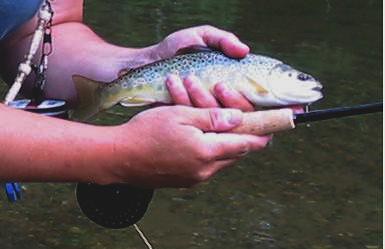 We waded back into the stream at a new location within the campground. I had no luck with B's ant or with lifted or drifted nymphs or with small streamers. A handful of fish started rising to the surface at 7 or 8 pm. I picked out one fish that was feeding on or near the surfade erratically. I watched him as I tied on a Turck's tarantula for lack of a better idea. He'd come up 3-5 times per minute for awhile, then disappear for 2-3 minutes. I couldn't see what he was eating. I casted the Turck's over him and he smashed it immediately. He was a nice little hunky 11" brown. He really thought he could kick my butt. He fought hard in the swift current and tried to wipe me off on a submerged stick. For a dark moment, I though he'd succeeded. He provided a very good challenge for my 3 weight and 5x tippet. I released him and he shot off into the murky depths. I spied 2 more risers upstream. I caught the first one - maybe a 10-incher - and B took a picture. I casted to the second fish, but he would not be fooled. I tried the Turck's on another fish, futher upstream, but he wanted nothing to do with it either. I waded downstream toward B. She had had no luck since the 2 she caught when we first started, but remained optimistic. I was getting chilly, so I headed back toward the car. Along the way, I spotted a nice riser sipping the surface near a canoe put-in and decided to try the Turck's on him. On the 2nd cast, he took it and headed directly to the bottom of his deep seam. I had a hard time moving him even downstream for a moment. What strong-willed little trout in this river! I finally landed him - he was another little 11" football - and released him quickly. The brown trout in this stream have typical big black and red spots but a much more colorful yellow underbelly than the strains in many other systems. We also noted the apparent lack of little fish in this river. Perhaps this stream is managed in such a way that the tiny little fish are simply not a large portion of the overall population.
We waded back into the stream at a new location within the campground. I had no luck with B's ant or with lifted or drifted nymphs or with small streamers. A handful of fish started rising to the surface at 7 or 8 pm. I picked out one fish that was feeding on or near the surfade erratically. I watched him as I tied on a Turck's tarantula for lack of a better idea. He'd come up 3-5 times per minute for awhile, then disappear for 2-3 minutes. I couldn't see what he was eating. I casted the Turck's over him and he smashed it immediately. He was a nice little hunky 11" brown. He really thought he could kick my butt. He fought hard in the swift current and tried to wipe me off on a submerged stick. For a dark moment, I though he'd succeeded. He provided a very good challenge for my 3 weight and 5x tippet. I released him and he shot off into the murky depths. I spied 2 more risers upstream. I caught the first one - maybe a 10-incher - and B took a picture. I casted to the second fish, but he would not be fooled. I tried the Turck's on another fish, futher upstream, but he wanted nothing to do with it either. I waded downstream toward B. She had had no luck since the 2 she caught when we first started, but remained optimistic. I was getting chilly, so I headed back toward the car. Along the way, I spotted a nice riser sipping the surface near a canoe put-in and decided to try the Turck's on him. On the 2nd cast, he took it and headed directly to the bottom of his deep seam. I had a hard time moving him even downstream for a moment. What strong-willed little trout in this river! I finally landed him - he was another little 11" football - and released him quickly. The brown trout in this stream have typical big black and red spots but a much more colorful yellow underbelly than the strains in many other systems. We also noted the apparent lack of little fish in this river. Perhaps this stream is managed in such a way that the tiny little fish are simply not a large portion of the overall population.
We quit fishing and packed up our gear at about 9:30 so we could catch some of Game 7 of the NBA finals on TV somewhere. The TV at our cabin recieved 2 channels, but not the one broadcasting the game. We headed into Luther to the Loggers Landing bar. They were showing the game on their big screen, so we ordered a pizza and settled in. In order to view the big TV screen, we had to choose a table next to a table of pretty rowdy, inebriated locals. It was the typical scenario of 3 or 4 drunk men having fun harassing 3 or 4 drunk women. I don't really understand why, but the women were apparently enjoying harassment. One especially drunk older woman repeatedly asked us "if the game was still tied." It was a big screen, anyone could watch or look at the score, but it was clear to everyone that we were the only ones paying attention to it. Each time we answered, yes or no, she informed us that "it doesn't really matter, it's all about the money anyway." Everytime.
The pizza was pretty good and the Pistons lost a nail-biter to the new champions - San Antonio Spurs. Feeling disappointed and a little displaced, we paid our bill and high-tailed it out of the bar back to our comfy cabin. It was a slightly awkward end to a great day on the river.
 Stats
Stats
Probability of revisiting stream locations fished: 1:1
Pickled ring bologna smackdown: Koegel's over Eckrich
Wildlife sightings: ~30 redstarts, 1 snapping turtle, zillions of butterflies and skippers
Today's Hex Hatch Rating: Huh? What's a hex?
Did I get to use a spey rod? No
Enjoyment grade for the day: A, awesome right up to the end of the Piston's game...
Big Manistee Fishing Report [June 22 2005]
Day 3 of vacation...
 oddly enough, began with a late morning! We got up, ate breakfast, made some PB&J sandwiches for lunch and dinner and headed off toward Harrietta to fish the Big Manistee and one of its tributaries, Slagle Creek. The day was again very hot (~95 F), clear and sunny. Not perfect fishing conditions, but near perfect enjoy-the-river-anyway conditions. The job of finding our target location, the mouth of Slagle Creek in the Manistee, was not straight forward. We made several wrong turns but eventually found our parking spot at the end of a long and circuitous two-track on top of a high bluff over the Manistee. This location is within the Huron-Manistee National Forest and, note to self, camping is apparently permitted here. We hiked a short distance to the top of the bluff overlooking the big river below and enjoyed the view for a few minutes. The river below is big (1200 ft3/s) and it winds back and forth through its deep riverbed of sand, gravel and the occasional large tongue of sticky, slippery clay. We breathed in the beauty of the view, then collected our wits and headed down the long path to the river with our fly rods. The footpath follows Slagle Creek all the way to it's mouth. As we hiked down, we were perplexed why anyone would claim to have fished the little creek - it's such a narrow, steep, cold, brush- and log-covered trickle. We didn't even notice anything you could call 'pocket water' on our hike down. But, we'll get back to this stream later...
oddly enough, began with a late morning! We got up, ate breakfast, made some PB&J sandwiches for lunch and dinner and headed off toward Harrietta to fish the Big Manistee and one of its tributaries, Slagle Creek. The day was again very hot (~95 F), clear and sunny. Not perfect fishing conditions, but near perfect enjoy-the-river-anyway conditions. The job of finding our target location, the mouth of Slagle Creek in the Manistee, was not straight forward. We made several wrong turns but eventually found our parking spot at the end of a long and circuitous two-track on top of a high bluff over the Manistee. This location is within the Huron-Manistee National Forest and, note to self, camping is apparently permitted here. We hiked a short distance to the top of the bluff overlooking the big river below and enjoyed the view for a few minutes. The river below is big (1200 ft3/s) and it winds back and forth through its deep riverbed of sand, gravel and the occasional large tongue of sticky, slippery clay. We breathed in the beauty of the view, then collected our wits and headed down the long path to the river with our fly rods. The footpath follows Slagle Creek all the way to it's mouth. As we hiked down, we were perplexed why anyone would claim to have fished the little creek - it's such a narrow, steep, cold, brush- and log-covered trickle. We didn't even notice anything you could call 'pocket water' on our hike down. But, we'll get back to this stream later...
I chose to exercise my 7 wt spey rod. I don't get that many chances to fish with it in the summer and this river section is a perfect opportunity. I tied on a heavy sink tip and a white zoo cougar. I caught a large 17" rainbow in this general vicinity last fall on a white articulated zoo cougar and I couldn't stop myself from tying on something similar. I choose flies this way a lot. It's not usually the most intelligent thing to do, but I can't help myself. It's like trying to plant a straight row when the disk/plow/rototiller marks are crooked. Know what I mean? I just can't go away from a fly that worked last time. Anyway, we arrived at the bottom to find the creek mouth emptying it's cold, cold water into a swift, bright blue-green, undulating river. The water flows very swiftly here and, where the bottom rises and the water becomes shallow enough to wade, can easily knock you off your feet. I swung some big streamers and B drifted big dry attractor patterns in several spots with no results. We hiked back up to the car for a snack after an hour or so.
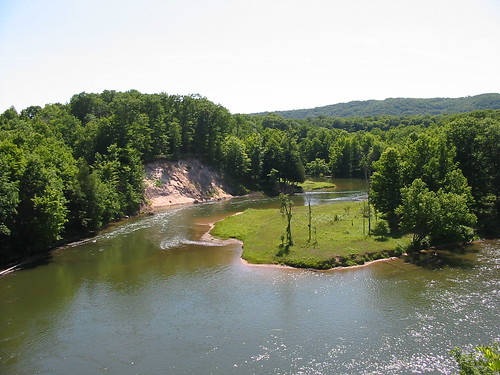 We ate a little lunch and drove upstream to fish Slagle Creek near a bridge. Here, the creek is a completely different animal than the steep, splashy trickle we observed near its mouth. Here, the creek is wider, 20-25' wide, with occasional undercut banks, logjams and deep holes. Its depth varies from 1 to 4' deep. I addressed it with my little 6' 3 weight and wet flies and nymphs. B tied her ant pattern and caught a couple of little 'bows. I had a million hits but hooked only one. There were lots of small, eager, acrobatic trout here. And deer flies. After fishing this upper stretch of Slagle Creek, it is easier to imagine the presence of the big fish of which we've heard stories. We hiked back to the car for another snack and then drove north to check out another small stream we've heard fantastic stories about. That stream did not meet our expectations so I won't even mention its name.
We ate a little lunch and drove upstream to fish Slagle Creek near a bridge. Here, the creek is a completely different animal than the steep, splashy trickle we observed near its mouth. Here, the creek is wider, 20-25' wide, with occasional undercut banks, logjams and deep holes. Its depth varies from 1 to 4' deep. I addressed it with my little 6' 3 weight and wet flies and nymphs. B tied her ant pattern and caught a couple of little 'bows. I had a million hits but hooked only one. There were lots of small, eager, acrobatic trout here. And deer flies. After fishing this upper stretch of Slagle Creek, it is easier to imagine the presence of the big fish of which we've heard stories. We hiked back to the car for another snack and then drove north to check out another small stream we've heard fantastic stories about. That stream did not meet our expectations so I won't even mention its name.
We drove back toward Mesick, around the north side of Hodenpyl dam to the suspension bridge area of the Big Manistee River for some evening fishing. Our fingers were crossed in hopes of a nice big bug hatch and/or spinner fall. We set up at a bend just downstream from the bridge before dusk. Fish were rising everywhere. However, I could not identify significant numbers of any particular insect presence. I saw a couple of gray drakes and a few light colored caddisy-looking flies, but no major hatch of any one bug. And some of the bugs I did see floated downstream unnoticed by the rising trout below. The fish were leaping half- or entirely clear of the water on many of their rises, so we suspected they might be after emerging bugs of some sort. Some of the rainbows jumping out of the river on the far bank were extremely big fish - in the 20+" category. Or course, even with my spey rod, they were well out of reach. We were joined by a couple of rude anglers who jumped into the river way to close to us given that we had long stretches of river available on either side of us. One even wedged himself between B and I for awhile - it seemed like steelhead season. They didn't stay long. I got a few smacks on attractors, hex and gray drake dries, but not as many as I would have liked and nothing was working consistently. I ultimately switched to skittering a muddler across the surface, but only encouraged strikes by trout too small to be hooked. I was frustrated, but still managed to enjoy the spectacle of the big, beautiful fish wrecklessly smashing bugs at the surface. B was downstream in a flatter, quicker section lifting and swinging picket pin and bird's nest nymphs and her ant and had good results. She caught a bunch of gorgeous rainbows in the 10-12" size range. I tried lifting and swinging soft hackle wet flies in the 2 seams I was fishing and could not duplicate B's results. The fish action slowed down a bit as darkness fell and then turned on and off again several times. Eventually, the feeding slowed to infrequent, little-fish slurps. We fished on until about 11:45 and decided to call it a night. We discovered that ours was the last car left in the parking area again.
We joked on the long drive home that the schedule we were keeping during this week of hex hunting was beginning to approach drug-dealer's hours....
Stats
Food obsession so far this week: pickled bologna
Today's Hex Something Hatch Rating: bonkers
Chances of revisiting stream locations fished: 1:1
Did I get to use a spey rod? Yes!
Enjoyment grade for the day: A, would have preferred more/bigger fish, but no complaints
Anything of value must be 'engineered.'
I read an article in a local paper a couple of weeks ago about a university researcher who 'discovered' a soil fungus that has potential for improving the efficiency with which plants take up nitrogen. The article was more or less based on a short article published in the June 9 issue of Nature and a subsequent interview with a couple of its authors. It's an interesting paper and is discussed in part elsewhere. The local newspaper article I read was typically disappointing and that's where I place my focus here. The journalist portrayed the scientists as super-human heroes and the technological potential of their ideas, glamorous and limitless. After fitting a few quotes from two of the Nature authors about the complexity of nature and the need to make better use of natural systems, the journalist glosses over his own words and most of the technical detail and ends his newspaper article with:
Lammers said the ultimate goal is to be able to genetically modify the fungi to increase their level of interaction with plants, although Shachar-Hill said the fungi could be capable of higher levels already.
At first this newspaper article didn't capture my attention. It's another typically oversimplified, cookie-cutter summary of some detailed biological research meant to make readers hope, one day in some shiny plastic future, we'll be able to 'save' and 'improve' ourselves by applying their new discoveries to our everyday lives. Give me a break. But then the absurdity of the last line, within and without the context of the article, really annoyed me and started me on this little rant...
Problem #1: Now, for the record, I'm a scientist too. I certainly don't mean to slam everyone in the broad field of scientific endeavor, but isn't there a saner way to approach scientific inquiry than to set out to 're-engineer' nature? Why are our objectives so often to 're-engineer' some existing biological organism or system (or worse yet, to create a new organism or system)? The creatures, chemicals, and communities currently in place have developed and adapted over hundreds of millions of years of selective evolutionary pressures; do we really think we are likely to 'improve' on these designs in a decade or two of molecular re-organization? Are we really so vain? Apparently many of us are. I am not really arguing that we should abandon these fields tout suite as I'm confident suitable applications exist. But jeez-o-pete, sometimes our vanity is simply astonishing. I won't go any further than to mention that we also are mostly clueless about the long-term and cascading effects an 'engineered' organism or chemical has on its immediate community and on the larger environmental landscape.
Can we please spend a little more time studying existing natural organisms and systems and identify the ways we can gently nudge them and continue to coexist with them? Do we really think we've completed this phase of biological research? I think many of us are under the impression that we already understand everything in nature and now we're ready to make and introduce new chemicals and organisms into the world. We're not. There are millions of things we still don't know. We still don't understand how cells differentiate or how our brains remember things. We still can't provide some really practical services like curing the common cold, predicting earthquakes or cleaning up our messy environment. Do we need to rearrange DNA to find these answers? I doubt it. I think we need to ask more questions, ask smarter questions, and access adequate funding while reducing corporate influences and reducing our overemphasis of short-term impacts. Pretty simple, eh?
Problem #2: And isn't there another way to communicate our work and our ideas to the general public than to appear in these ridiculously over-simplified news articles? I also don't want to slam the field of journalism, though it's often tempting. We've come to expect these insipid, sweet-but-flavorless, descriptions of scientific progress and potential. I bet the scientists and journalists themselves don't even recognize what an incredibly bad service they're providing as they're creating these awful documents. Perhaps we've reached the point in our technological specializations where we need a better 'go-between' to communicate information from the scientists who've discovered it to the public at large. I don't think it's a ridiculous idea to think we could easily accomplish this. We all know where to find a Coke and what the Nike logo looks like. Can we maybe communicate some important scientific findings even a tenth as effectively?
In order to accomplish this goal, we'll probably have to train a new category of professionals. Or we'll have to train journalists, teachers, and other agents a bit better in this way. The current systems train scientists to communicate well with each other, but not with anyone else. And we inform and educate the general population on only the most basic, anecdotal portions of our enormous pool of scientific understanding. It seems we've lost our collective understanding of the scientific method, evolution, cause-and-effect relationships, etc. Even I, as a scientist, am left unable to differentiate myth from fact on some unfamiliar topics. Most of us received our basic scientific training in elementary and high school and in college if we were lucky enough to have attended. After that, scientific understanding is rarely revisited or reinforced unless we involve ourselves directly in the field. We have very limited access to science and scientific findings after completing our formal education. I think we need well-trained communicators to bridge this gap.
I would enjoy your comments...
Little Manistee Fishing Report [June 21 2005]
Day 2 of the OCFF vacation...
...began with a late wake-up time. We were tired from the preceding week and weekend and we'd stayed up fairly late the night before. Plus, we were on vacation dang it! The forecast of overnight thunderstorms never materialized. Though we didn't necessarily desire thunderstorms during our outdoor vacation, the area was desperately dry and we would've gladly made the sacrifice for a little precipitation.
We were so anxious to arrive and get some fishing in the day before, we had not included a thorough food shopping stop enroute to the cabin. So we made a quick morning trip to Baldwin for groceries. After returning with our food stores, we grabbed our gear and headed for the Bear Track access for some early afternoon fishing.
We had the campground and the river to ourselves. The river here is a bright sandy-bottomed, log-jam rich stretch that averages about 30 feet across and undulates from 1 to 4 feet deep. The banks are lined with hardwood trees, underwater lumber and well-shaded trout hiding places. The low clear water, bright sunny sky and early afternoon hour reduced our expectations of fish. If we caught anything while enjoying the sunny afternoon, it would simply be a bonus. I headed upstream and B waded down. I immediately encountered a couple of little risers, but struggled to find a fly to match their preferences. I did manage a couple of short strikes but no hookups. Eventually I gave up on them and waded up through their lane. In a couple hours of fishing, we worked hard to catch a reasonable number of small 5-7" rainbows on dries and soft-hackle wets. Definitely bonus fish.
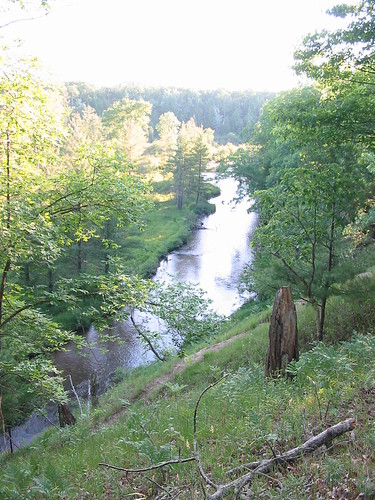 We took a break for a little snack and decided to change venues to 6-Mile bridge. Here, we fished just a short stretch and had no hookups. We moved downstream to a favorite access at Chicago Boy Rollway and fished there until dark. This is a gorgeous stretch of winding stream that flows around a large island over a gravel and sand bottom through steep tree- and grass-lined banks. We fished here one afternoon several years ago and had one of the most enjoyable afternoons ever in a river. That bright day, we had the stream to ourselves and caught many brookies, browns and rainbows from 6 to 12". Some non-fishing friends had accompanied us and spent their afternoon napping and swimming somewhere downstream. Fun was had by all. This time, I again waded upstream and B headed down. I fished up, and then down, 2 or 3 deep bends with old, effective, man-made improvements and overhanging trees. Very fishy water. I again encountered a couple of risers that teased me with short strikes but no hookups. Probably little guys. I stepped over a recently-deceased steelhead stuck under a branch. Are there skamania in this river? He was not silver -bright, but had not been dead long. An unsuccessful C&R? Maybe just normal mortality.
We took a break for a little snack and decided to change venues to 6-Mile bridge. Here, we fished just a short stretch and had no hookups. We moved downstream to a favorite access at Chicago Boy Rollway and fished there until dark. This is a gorgeous stretch of winding stream that flows around a large island over a gravel and sand bottom through steep tree- and grass-lined banks. We fished here one afternoon several years ago and had one of the most enjoyable afternoons ever in a river. That bright day, we had the stream to ourselves and caught many brookies, browns and rainbows from 6 to 12". Some non-fishing friends had accompanied us and spent their afternoon napping and swimming somewhere downstream. Fun was had by all. This time, I again waded upstream and B headed down. I fished up, and then down, 2 or 3 deep bends with old, effective, man-made improvements and overhanging trees. Very fishy water. I again encountered a couple of risers that teased me with short strikes but no hookups. Probably little guys. I stepped over a recently-deceased steelhead stuck under a branch. Are there skamania in this river? He was not silver -bright, but had not been dead long. An unsuccessful C&R? Maybe just normal mortality.
We fished here until dark (about 10:00 pm), caught a handful of little rainbows and steelhead smolts, but observed no big bug hatches. After another break at the car for a sandwich and a drink, we decided to head back to 6-Mile bridge in hopes of some nighttime big bug action. Here, we joined a couple of cars already parked in the parking area and assumed positions just up and just down from the bridge. We heard a few risers, saw a couple of hex but definitely not the hatch or spinner fall we had hoped for. Becky caught a couple of smallish trout but I had no strikes. Neither of us got any strikes on hex or gray drake dries. We packed up at about 11:30 and headed back toward Luther.
 I had to hit the brakes about 10 times for deer in the road on the way back. I had started joking about the local wildlife and their taste for 'life on the edge', when we passed a momma cat nursing 2 kittens at the gravel edge of the road. What the heck? Someone had probably dropped them off. We stopped to figure out an appropriate plan. At least we'd hoped to get them off the edge of the road and out of danger. Momma cat was pretty protective and did not appreciate the intrusion. After some soft invitations and a slow approach, she let me touch her, scratch her behind the ears and then pick up her kittens. After depositing the 2 fuzzy little kittens in the grass, they pounced right back onto the pavement chasing after bugs in our headlight beams. Very cute, but also very nerve-wracking. We eventually enticed them into the grassy ditch with the remainder of our cheese - we scattered lots of little chunks around to keep them hunting for awhile. We left them there in the grass and hoped they would stay out of the road and that someone living in the area might take them in. We felt like we had no better options at that point in time.
I had to hit the brakes about 10 times for deer in the road on the way back. I had started joking about the local wildlife and their taste for 'life on the edge', when we passed a momma cat nursing 2 kittens at the gravel edge of the road. What the heck? Someone had probably dropped them off. We stopped to figure out an appropriate plan. At least we'd hoped to get them off the edge of the road and out of danger. Momma cat was pretty protective and did not appreciate the intrusion. After some soft invitations and a slow approach, she let me touch her, scratch her behind the ears and then pick up her kittens. After depositing the 2 fuzzy little kittens in the grass, they pounced right back onto the pavement chasing after bugs in our headlight beams. Very cute, but also very nerve-wracking. We eventually enticed them into the grassy ditch with the remainder of our cheese - we scattered lots of little chunks around to keep them hunting for awhile. We left them there in the grass and hoped they would stay out of the road and that someone living in the area might take them in. We felt like we had no better options at that point in time.
Back at the cabin, we slipped down to the stream and took a few casts into the dark. We hooked a couple more little, non-discriminating brookies. No big fish, but we caught quite a few small fish on the day. As Shupac says, "sometimes small really is beautiful."
Stats
Hex Hunting Cooking/Meal Planning tip: Dinner is over-rated. Pack 2 lunches. Stay out late.
Today's Hex Hatch Score: flat line
Wildlife sightings: ~30 deer, 1 porcupine, 3 domestic short-hairs
Did I get to use a spey rod? No.
Enjoyment score for the day: A-, disappointing lack of big bugs, but sun + stream + trout = success
New family addition - Dylan
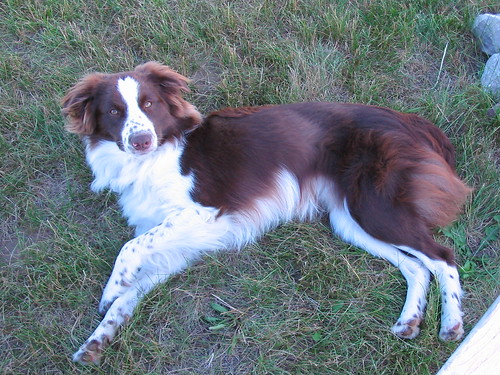 We're spending our holiday weekend welcoming and adjusting to our new family member, Dylan. He's a 10-month old, well-mannered, people-centered border collie. Someone docked his tail somewhere along the way for some reason. B found him through the Great Lakes Border Collie Rescue organization.
We're spending our holiday weekend welcoming and adjusting to our new family member, Dylan. He's a 10-month old, well-mannered, people-centered border collie. Someone docked his tail somewhere along the way for some reason. B found him through the Great Lakes Border Collie Rescue organization.
We've been a dogless household for over a year after losing our previous border collie, Keen, very suddenly. Transitioning from a 2-dog household to a 1-dog, to a 0-dog family was difficult. Though we grew to appreciate the freedom and flexibility of our dog-free state, we were not within our comfort zone. I think we found a very good match in Dylan.
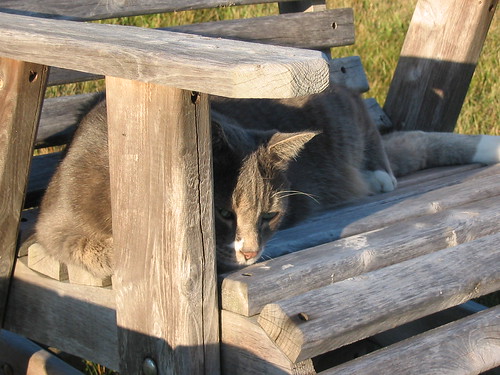 Our 8-year old fat cat Casper, is very happy to have a dog in the house again. He follows Dylan around at a comfortable distance and they shared the shade of the closest pine tree for quite awhile while I worked in the garden this afternoon. The other 3 cats are adjusting more slowly...
Our 8-year old fat cat Casper, is very happy to have a dog in the house again. He follows Dylan around at a comfortable distance and they shared the shade of the closest pine tree for quite awhile while I worked in the garden this afternoon. The other 3 cats are adjusting more slowly...
USA Today founder calls Bush a 'liar'
From Friday's Editor & Publisher (via Rox Populi):
Neuharth Calls For U.S. Withdrawal from Iraq, Says Bush 'Lied'
NEW YORK USA Today founder Al Neuharth, who caused a stir last year when -- a bit ahead of the curve -- he told E&P that he favored a U.S. withdrawal from Iraq, re-iterated his position Friday, with even more force.
“I'm convinced the best way to support our troops in Iraq is to bring them home. Sooner rather than later,” Neuharth, a Bronze Star winner in World War II, declared. He also compared President Bush to President Lyndon B. Johnson, saying that both presidents “lied to us in wartime.”
Neuharth added, in his weekly column Friday in the newspaper he founded: “The crucial difference between Vietnam and Iraq is that there is no Cronkite to call Bush's bluff. Without a strong, trusted, non-political voice, too many of us remain Bush-blinded. Bush tried keeping the wool over our eyes again Tuesday on national TV by repeatedly tying Iraq to 9/11. That charge is as phony as his discredited prewar claim that Saddam Hussein had weapons of mass destruction.”
[...]
Any other MSM-folk want to step up?
The Fly Fishing Loop is sponsored by flydepot.com
[ Home Waters | Next | Random | List | Search ]

This work is licensed under a Creative Commons Attribution-NonCommercial-ShareAlike 2.5 License.






